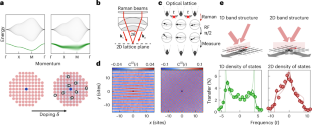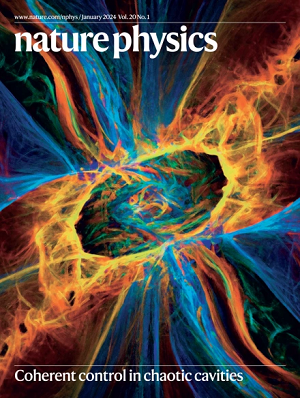费米-哈伯德模型中的磁偶极子
IF 18.4
1区 物理与天体物理
Q1 PHYSICS, MULTIDISCIPLINARY
引用次数: 0
摘要
磁激励与流动载流子的相互作用是强相关电子系统中普遍存在的现象。一个关键的理论问题是理解磁绝缘体掺杂后磁振子准粒子的重整化,这是一种集体自旋激发。在这里,我们观察到一种新的准粒子——磁子-费米极化子——是由一个磁子与冷原子费米-哈伯德系统的掺杂空穴进行修饰而产生的。在掺杂的自旋极化带绝缘体中,利用控制动量的拉曼激发,研究了磁振子极化子的光谱特性。在具有强相互作用的未掺杂系统中,光激发产生磁振子,其性质可以用自旋波理论精确描述。我们测量了光激发光谱的演化,当我们离开这个极限产生磁振子时,由于磁振子被电荷激发修饰而产生磁振子。我们观察到极化子的能量在掺杂后发生了位移,这种位移强烈依赖于注入的动量,同时伴随着探测能量窗口中谱权的减小。我们预计,这里介绍的技术,即非弹性中子散射的模拟,将为原子量子模拟器提供在强相关相中获得各种激发的动力学的途径。本文章由计算机程序翻译,如有差异,请以英文原文为准。


Magnon-polarons in the Fermi–Hubbard model
The interplay of magnetic excitations and itinerant charge carriers is a ubiquitous phenomenon in strongly correlated electron systems. A key theoretical question is understanding the renormalization of the magnon quasiparticle, a collective spin excitation, upon doping a magnetic insulator. Here we observe a new type of quasiparticle—a magnon-Fermi-polaron—arising from the dressing of a magnon with the doped holes of a cold-atom Fermi–Hubbard system. Using Raman excitation with controlled momentum in a doped, spin-polarized band insulator, we address the spectroscopic properties of the magnon-polaron. In an undoped system with strong interactions, photoexcitation produces magnons, whose properties are accurately described by spin-wave theory. We measure the evolution of the photoexcitation spectra as we move away from this limit to produce magnon-polarons due to dressing of the magnons by charge excitations. We observe a shift in the polaron energy with doping that is strongly dependent on the injected momentum, accompanied by a reduction of spectral weight in the probed energy window. We anticipate that the technique introduced here, which is the analogue of inelastic neutron scattering, will provide atomic quantum simulators with access to the dynamics of a wide variety of excitations in strongly correlated phases. In strongly correlated systems, how magnetic excitations are renormalized by charge carriers remains an open question. An experiment now reports the observation of magnon-polarons—magnons dressed by doped holes—in a Fermi–Hubbard quantum simulator.
求助全文
通过发布文献求助,成功后即可免费获取论文全文。
去求助
来源期刊

Nature Physics
物理-物理:综合
CiteScore
30.40
自引率
2.00%
发文量
349
审稿时长
4-8 weeks
期刊介绍:
Nature Physics is dedicated to publishing top-tier original research in physics with a fair and rigorous review process. It provides high visibility and access to a broad readership, maintaining high standards in copy editing and production, ensuring rapid publication, and maintaining independence from academic societies and other vested interests.
The journal presents two main research paper formats: Letters and Articles. Alongside primary research, Nature Physics serves as a central source for valuable information within the physics community through Review Articles, News & Views, Research Highlights covering crucial developments across the physics literature, Commentaries, Book Reviews, and Correspondence.
 求助内容:
求助内容: 应助结果提醒方式:
应助结果提醒方式:


